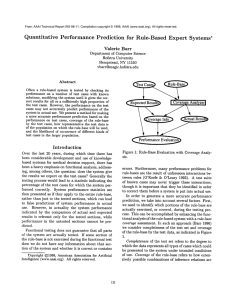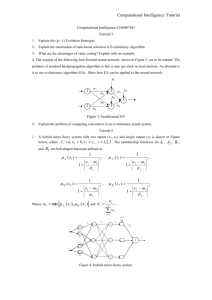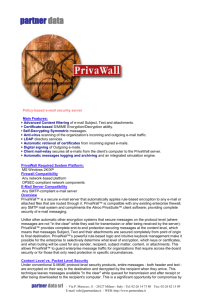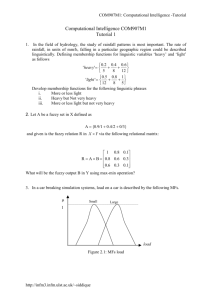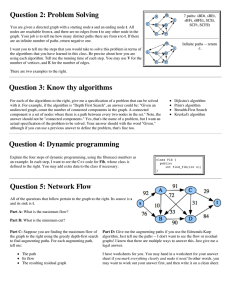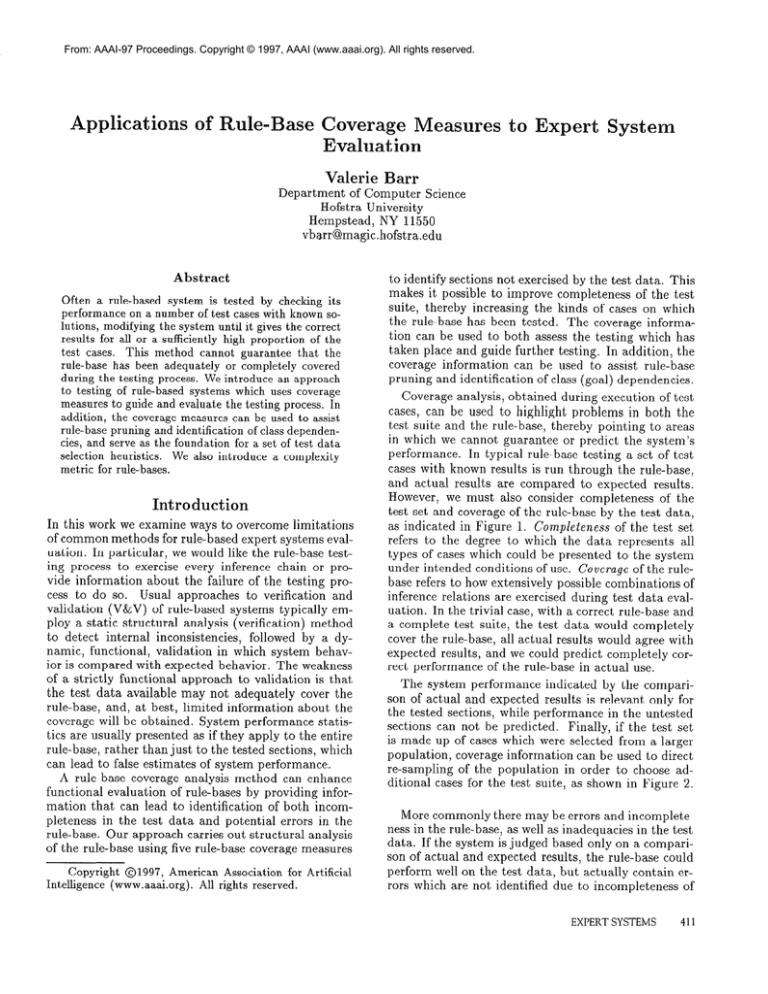
From: AAAI-97 Proceedings. Copyright © 1997, AAAI (www.aaai.org). All rights reserved.
Applications
of Rule-Base
Coverage Measures
Evahat ioln
Valerie
to Expert
System
Barr
Department
of Computer
Science
Hofstra University
Hempstead,
NY 11550
vbarr@magic.hofstra.edu
Abstract
Often a rule-based
system is tested by checking its
performance on a number of test cases with known solutions, modifying the system until it, gives the correct
results for all or a sufficiently high proportion
of the
test cases. This method cannot guarantee
that the
rule-base has been adequately
or completely covered
during the testing process. We introduce an approach
to testing of rule-based systems which uses coverage
measures to guide and evaluate the testing process. In
addition, the coverage measures can be used to assist
rule-base pruning and identification
of class dependencies, and serve as the foundation
for a set of test data
selection heuristics.
We also introduce
a complexity
metric for rule-bases.
Introduction
In this work we examine ways to overcome limitations
of common methods for rule-based
expert systems evaluation.
In particular,
we would like the rule-base
testing process to exercise every inference
chain or provide information
about the failure of the testing process to do so. Usual approaches
to verification
and
validation
(V&V)
of rule-based
systems typically
employ a static structural
analysis (verification)
method
to detect internal
inconsistencies,
followed
by a dynamic, functional,
validation
in which system behavior is compared
with expected
behavior.
The weakness
of a strictly
functional
approach
to validation
is that
the test data available
may not adequately
cover the
rule-base,
and, at best, limited
information
about the
coverage will be obtained.
System performance
statistics are usually presented
as if they apply to the entire
rule-base,
rather than just to the tested sections, which
can lead to false estimates
of system performance.
A rule-base
coverage analysis method
can enhance
functional
evaluation
of rule-bases
by providing
information
that can lead to identification
of both incompleteness
in the test data and potential
errors in the
rule-base.
Our approach
carries out structural
analysis
of the rule-base
using five rule-base
coverage measures
Copyright
@1997,
American Association for Artificial
Intelligence
(www.aaai.org).
All rights reserved.
to identify sections not exercised by the test data. This
makes it possible to improve
completeness
of the test
suite, thereby
increasing
the kinds of cases on which
the rule-base
has been tested.
The coverage information can be used to both assess the testing which has
taken place and guide further testing.
In addition,
the
coverage information
can be used to assist rule-base
pruning
and identification
of class (goal) dependencies.
Coverage analysis, obtained
during execution
of test
cases, can be used to highlight
problems
in both the
test suite and the rule-base,
thereby
pointing
to areas
in which we cannot guarantee
or predict
the system’s
performance.
In typical rule-base
testing a set of test
cases with known results is run through
the rule-base,
and actual results are compared
to expected
results.
However,
we must also consider
completeness
of the
test set and coverage of the rule-base
by the test data,
as indicated
in Figure 1. Completeness
of the test set
refers to the degree to which the data represents
all
types of cases which could be presented
to the system
under intended
conditions
of use. Coverage of the rulebase refers to how extensively
possible combinations
of
inference
relations
are exercised
during test data evaluation.
In the trivial case, with a correct rule-base
and
a complete
test suite, the test data would completely
cover the rule-base,
all actual results would agree with
expected results, and we could predict completely
correct performance
of the rule-base
in actual use.
The system performance
indicated
by the comparison of actual and expected results is relevant
only for
the tested sections, while performance
in the untested
sections can not be predicted.
Finally,
if the test set
is made up of cases which were selected from a larger
population,
coverage information
can be used to direct
re-sampling
of the population
in order to choose additional
cases for the test suite, as shown in Figure 2.
More commonly
there may be errors and incompleteness in the rule-base,
as well as inadequacies
in the test
data. If the system is judged based only on a comparison of actual and expected results, the rule-base
could
perform
well on the test data, but actually
contain errors which are not identified
due to incompleteness
of
EXPERT
SYSTEMS
411
Figure
sis.
1: Rule-Base
Evaluation
with
Coverage
Analy-
the test data. This could lead to a false prediction
of
correct performance
on all cases, when in fact we cannot make any accurate prediction
about performance
of the rule-base
in those areas for which there is an
absence of test data.
Analysis
of the coverage resulting
from execution
of
the test data allows for several types of rule-base
analyses and refinements.
Lack of coverage results from
either incompleteness
of the test data or errors in the
rule-base.
Using coverage measures and heuristics
for
test case selection allows us to improve
the completeness of the test suite and increase coverage of the rulebase, thereby
increasing
the kinds of cases for which
the rule-base
has been executed during testing.
This
work
builds
on both
coverage-based
testing methods
for procedural
software
(see (Adrion,
Branstad,
& Cherniavsky
1982) for a review of methods and (Frank1
& Weyuker
1985) for a data-flow
approach
to testing)
and earlier
work on rule-base
analysis.
Early approaches
for rule-base
analysis carried out only verification
or validation.
A number of systems,
such as ONCOCIN
(Suwa,
Scott,
& Shortliffe
1982) and others,
carry out only verification.
A number
of dynamic
analysis
tools were
also developed,
such as TEIRESIAS
(Davis
1984),
which aids in debugging
and knowledge
acquisition,
and SEEK2
(Ginsberg,
Weiss, & Politakis
1985), a
rule-base
refinement
tool. As the field of verification
and validation
matured,
criticisms
of the existing
approaches
(Andert
1993; Nazareth
1989; Andert
1992;
Rushby 1988) have led to the development
of a number
of new approaches,
of which the work described
here is
one. COVER
(Completeness
VERifier)
(Preece 1989;
Preece & Shinghal
1992) is another
approach
which
combines both a functional
and structural
analysis of
the rule-base.
In addition
to the hierarchy
of rule-base
coverage
measures, we describe a rule-base
representation
which
facilitates
application
of the coverage measures;
a set
of heuristics
for re-sampling
the population
of available test cases, based on coverage information;
strategies for rule-base
pruning
and identification
of classdependencies;
a rule-base
complexity
metric.
In other
work (Barr 1996) the utility
of the above is illustrated
extensively
using rule-bases
which were prototypes
for
the AI/RHEUM
system (Kingsland
1985).
I
Testing
Figure 2: Evaluation
Re-sampling.
412
KNOWLEDGE
with
Coverage
REPRESENTATION
Analysis
and Data
with
Rule-Base
Measures
Coverage
The first step in rule-base
testing with coverage measures is to build a graph representation
of the rule-base.
Our method
uses a directed
acyclic graph (DAG)
represent ation.
We assume a generic propositional
rulebase language
(Barr 1996) into which other rule-base
languages
can be translated.
During
construction
of
the DAG, pairwise
redundant
rules, pairwise
simple
contradictory
rules and potential
contradictions
(ambiguities)
are identified.
After DAG construction
is
complete, static analysis (verification) of the rule-base
reports dangling conditions (an antecedent component
that is not defined as a finding and is not found as
the consequent of another rule), useless conclusions,
and cycles in the rule-base. At this point the rule-base
could be modified to correct any static problems.
Next dynamic analysis is carried out using test cases.
As test cases are processed, one or more of several rulebase coverage measures (RBCMs) can be reviewed in
order to determine the quality of the test data supplied
thus far. Additional information about the rule-base
and its testing can also be used to guide the selection of
future test data. The tester would start by providing
sufficient test data to satisfy the simplest functional
measure (conclude each class of the system) and proceed to the more difficult structural measures. Finally,
if the user is unable to provide sufficient data to attain
the desired degree of rule-base coverage, the user can
use the DAG representation to synthesize data, which
can then be reviewed by an expert to determine if the
data represents a valid case in the problem domain.
This testing approach, described more fully below,
has been implemented in the TRUBAC tool (Testing
with Rule-BAse Coverage) (Barr 1996; 1995).
Rule-base
Representation
The DAG representation, which allows identification of
sections which have and have not been covered, or exercised, by the test data, is based on the AND/OR graph
implicit in the rule base (Meseguer 1991). The DAG
has a source node, corresponding to working memory,
and a sink node, corresponding to success in reaching
one of the classes (diagnoses or goals) of the system.
The two types of interior nodes are sub-class nodes
(SUBS) and operator nodes. Sub-class nodes represent
non-class rule consequents (intermediate hypotheses of
the system). Operator nodes are used to represent the
allowable operators AND, OR, and NOFM’. These operator nodes represent the fact that the conjunction
and/or disjunction of multiple components of an antecedent must be true in order for the conclusion of
a rule to be entered into working memory. There are
edges from the source to each finding and from each
class to the sink. The antecedent of each rule is represented by a subgraph which connects findings and
sub-class nodes to operators as indicated by the antecedent. Each antecedent-consequent
connection represented by a rule is also represented by an edge from
the subgraph for the antecedent to the node for the
consequent.
For example, the representation of the two rules
If Pl 64 P2 then Rl
If Rl 63’R2 then Q
is shown in Figure 3. PI, lp2 and R2 could be findings
1NOFM nodes represent the construction “if N of the
following M things are true, then...“, which is a feature of
EXPERT
(Weiss et al. 1987) rule-bases.
0
P2
Figure 3: DAG representation
of two related rules.
or sub-class nodes, while IL1 and & are either class or
sub-class nodes. The complete graph of a rule-base is
constructed by linking together the individual structure for successive rules. Using this framework we can
easily represent rule-bases, including those in which the
certainty factors are hard coded within the consequent
definitions.
de-base
coverage
measures
Each reasoning chain through the rule-base corresponds to a sub-DAG of the DAG representation. That
is, if we were to mark all nodes and edges in the DAG
that correspond to the rules fired during a particular chain of inferences, we would include: the source
node; the sink node; all nodes corresponding to the
findings involved; the class concluded; all nodes corresponding to antecedent components, operators, and
rule consequents; and all edges involved in antecedentconsequent links formed by the rule connections used
in the reasoning chain. A rule firing involves all edges
and nodes in the graph that corresponds to the rule.
An execution
path is the sub-DAG that corresponds to
all the rules fired along a particular reasoning chain
executed due to a specific set of findings.
Ideally, in testing a rule-base, we would like to provide sufficient test data to cause every possible execution path of the DAG to be traversed, which corresponds to the firing of all rules in every combination
possible. Since this is usually not reasonable in the
testing environment, we propose the following hierarchy of rule-base coverage measures (RBCMs) for rulebased systems in order to guide the selection of test
data and give an objective measure of how well a test
suite has covered the rule-base.
Satisfied if the test data causes traversal
of one execution path to each class of the system.
Each-class
Each-hypoth
Satisfied if the test data causes
traversal of execution paths such that each sub-class
is reached, as well as each class.
Each-class-every-sub
There may be many execution paths that connect each sub-class to each class
(and no execution paths for some sub-class to class
This coverage measure is satisfied
if, for each sub-class to class combination connected
by some execution path, at least one execution path
which includes the combination is executed.
combinations).
EXPERT
SYSTEMS
413
Each-class-every-finding
There may be many execution paths that connect each finding to each class
(and no execution
paths for some finding-class
combinations).
This coverage measure is satisfied if, for
each finding-class
combination
connected
by some
execution
path, at least one execution
path which
includes the combination
is executed.
‘.
All-edges
Satisfied if the data causes traversal
of a
set of execution
paths such that every inference
relationship
(every edge in the graph) is utilized
along
some inference
path. While this will not guarantee
that all rules will be used in every combination
possible, it will guarantee
that every rule is used in all
possible ways along some execution
path.
In a very complex rule-base,
or one for which there
is very little test data, using these criteria
will help
the tester determine
the ways in which the data has
been deficient in testing portions
of the rule-base.
The
coverage measures provide information
that will lead to
the acquisition
or development
of additional
test cases,
or will lead to the discovery of errors in the rule-base.
Additional
Applications
Analysis
of Coverage
In addition
to providing
information
about the testing process itself, the coverage analysis can be used to
enhance testing and facilitate
other kinds of rule-base
analysis, as described
below.
Heuristics
for Test
Data
Selection
It is often the case that there is a large pool of available
test data, from which a subset of cases must be selected
for the test suite due to the lengthy time necessary to
run all the available
cases. However,
a poor selection
of cases will lead to an incomplete
test set. We can use
the coverage information
as the foundation
of a set of
heuristics
for test data selection,
in order to construct
a test set that will maximize
rule-base
coverage.
To date we have restricted
our work to classification systems,
so each goal of the system is a class
and we consider
each intermediate
hypothesis
to be
a sub-class.
Assuming
that we have some degree of
meta-knowledge
about the make-up
of individual
test
cases (e.g., what facts or intermediate
hypotheses
are
involved
in each case), a set of heuristics
for data selection is:
1. For each class, select a test case which
that class.
concludes
only
2. For each class not yet tested, select a test case which
will conclude
it (and additional
classes).
3. Select test
classes.
cases which
will
conclude
unused
sub-
4. Select test cases which will cover sub-class to class relations, and direct finding
to class relations
for findings which do not lead to an intermediate
sub-class.
414
KNOWLEDGE
REPRESENTATION
PM
PM
PSS
SLE
MCTD
RA
Table
0
0
18.18
28.57
1: Overlap
PSS
0
9.09
9.09
14.29
SLE
0
16.67
0
0
of sub-classes
MCTD
22.22
16.67
0
RA
22.22
16.67
0
36.36
57.14
for class pairs.
to class re5. Select test cases which will cover finding
lations for findings which represent
alternative
ways
to conclude
sub-classes.
That is, while a sub-class
to class relation
may have been covered, there may
be multiple
ways to conclude
the sub-class.
Other work in this area (Barr 1996) shows that the
use of the coverage
information,
along with metaknowledge
about the pool of available
cases, is critical
to selecting the test cases in a way that contributes
to
a useful test of the rule-base.
This in turn gives greater
assurance that the system has been tested and works
correctly for the situations
that we expect to encounter
most often, as well as clearly identifying
those parts of
the system that still require more examination,
testing,
or refinement.
Class
Dependence
Another
aspect of rule-base
analysis
or evaluation
is
the identification
of class dependencies,
in which the
rules that lead to the conclusion
of one class are also
highly
involved
in the conclusion
of another
class. If
two classes, Cl and C2, are dependent,
and we have a
large number of test cases that we know will be classified as Cl, it may be that some of those cases will
also be classified
as C2. In this way, testing for one
class will also help us achieve coverage for the other.
Furthermore,
if Cl and C2 are dependent
classes and
we change rules for Cl then we should both rerun test
cases which we know conclude Cl, and rerun test cases
which we know conclude
C2 in order to verify that
changing
rules for Cl did not inadvertently
affect the
system’s ability to properly
classify C2 as well.
While shared findings does not imply rule sharing for
class pairs, to determine
if two classes do have rules in
common we look at sharing or overlap among the sets
of sub-classes that can lead to a class. If there is a high
degree of overlap among sub-classes then it does imply
overlap
among the rules and a degree of dependency
between those classes.
“This information
can be obtained
quite immediately
from data which is collected while the DAG representation is built.
We accumulate
for each class a list of
all the sub-classes which can help to conclude the class,
and then compare these lists for pairs of classes. Table 1 shows the overlap figures for a small prototype
of the AI/RHEUM
system for rheumatology
diagnosis (Kingsland
1985). The figures of interest are those
for RA and MCTD
(rheumatoid
arthritis
and mixed
connective
tissue disease). These figures indicate
that
57% of the sub-classes which lead to RA also lead to
MCTD,
while 36% of the sub-classes
which can lead
to MCTD
also lead to RA. The asymmetry
in these
figures results from the fact that the absolute number
of sub-classes which can lead to the classes is different.
These figures would indicate
that modifications
made
to the rules for RA would likely also affect the performance of the system on cases that should be classified
as MCTD,
while there would be a lesser affect on the
system’s classification
of cases as RA if the rules for
MCTD
were modified.
These results are consistent
with those found in (Indurkhya
199 1)) which uses Monte-Carlo
simulationbased techniques
to carry out rule-base
evaluation.
However,
in our approach
we obtain
the information
without
the overhead
of executing
the rule-base.
Rule-Base
Pruning
Once a rule-base has been constructed,
it may be possible that not all the rules are necessary for the rule-base
to perform
correctly.
For example,
during incremental development
some early rules may be supplanted
by rules added later. If the system can be pruned by
removing
rules or components
within
rules, and the
performance
on the test cases is not affected, then it
1 is possible that there were unnecessary
rules or that
the test cases are not adequate
to evaluate
the entire
rule-base
(Indurkhya
1991).
We use coverage information
to focus the pruning
steps on sections of the rule-base
which have not been
executed
by the test data. A section of the rule-base
that is never used or executed during evaluation
of the
test cases contains unnecessary
rules or the test suite is
not sufficiently
rich and additional
test cases are necessary to cause execution
of inference
paths through
the unexecuted
section of the rule-base.
It will be up
to the developer
and/or
the expert to decide whether
the proper approach
is to prune or to add test cases.
If we believe that the test suite is truly representative
of cases that will be found in the application
environment, and the rule-base
performs
correctly
on the test
set, then it is more likely that the uncovered
portion
of
the rule-base is in fact unnecessary
and can be pruned.
If the test set is complete
and the rule-base
performs
incorrectly
then the uncovered
sections of the rule-base
are candidates
for rule refinement.
The coverage measures will provide information
about why the rules were
never used, based on findings and sub-classes which appear in rule antecedents
but are not present in any test
cases. Removal
of these antecedent
components
from
the rules may generalize
them sufficiently
that they
will correctly
handle some of the test cases and will be
covered by some existing portion
of the test suite.
Figure
4: Graph
A Metric
of rule-base
for Rule-Based
with
OR and SUB.
Systems
The graph representation
proposed
here serves as a
suitable foundation
for a complexity
metric to predict
or measure the complexity
of the system and of the
testing process. The actual number of execution
paths
is based on the logical relationships
in the rule-base,
using the following
mechanism:
e For each class node, count one path for each edge
into the class node. In Figure 4 there are 2 paths
based on in-edges at class node G.
8 For each OR node, count one additional
path.
In
Figure 4 we count one more path to G at the OR
node.
o For each SUB node, consider the number
of parent
edges. As with an OR node, each parent edge represents a possible path which concludes
the sub-class.
One of these paths will be counted when the classes
are considered,
and we count additional
paths for
the additional
parent edges. In Figure 4 there are
a total of 5 paths to G: 2 at G, 1 more at the OR
node, and 2 more at the SUB node.
e for AND
nodes
no additional
paths
are added.
This execution
path metric can serve a number
of
purposes
in rule-base
development
and analysis.
The
total number
of execution
paths represents
the maximum number
of test cases needed for complete
coverage of the rule-base
according
to the strongest
rulebase coverage measure (All-edges).
However, usually
the actual number of data sets needed will be less than
the number
of execution
paths, since often, particularly in diagnosis
systems, one test set may cover a
number of execution
paths to different
diagnoses.
Conclusion
and
Future
Work
In this work we show that rule-base performance
evaluation can be misleading
unless care is taken to identify
problems
with both the test data and the rule-base.
Both the test data and the rule-base
can be improved
by using information
about the extent to which the test
data has covered the rule-base
under test. This work
can be extended in a number of directions.
A quantitative performance
prediction
can be developed
based on
performance
of the system on test cases, a measure of
EXPERT
SYSTEMS
415
how well the test data covers the rule-base,
and a measure of the degree to which the test set is representative
of the population
for which the system is intended.
A
second area of extension
is for systems which have dynamic computation
of certainty
factors, which requires
modification
of the rule-base
coverage measures (Barr
1996) as well as changes to the implementation
and the
data selection heuristics.
Finally, it may also be possible to extend this approach
to analysis of Bayesian belief networks.
The probabilistic
relationships
between
nodes of the network,
with information
flow which is
bi-directional
along the arcs, and nodes which may be
dependent
in some contexts and independent
in others,
significantly
complicates
this task.
References
Adrion,
W.; Branstad,
M.; and Cherniavsky,
J. 1982.
Validation,
verification,
and testing of computer
software. ACM Computing
Surveys 14(2):159-192.
Andert,
Jr., E. 1992. Automated
knowledge-base
validation.
In Workshop
on Validation
and Verification
of Knowledge-Based
Systems.
San Jose, CA: Tenth
National
Conference
on Artificial
Intelligence.
Andert,
Jr., E.
1993.
Integrated
design
and
V&V
of knowledge-based
systems.
In Working
Notes from
Workshop
on Validation
and Verification of Knowledge-Based
Systems. Washington,
D.C.:
Eleventh
National
Conference
on Artificial
Intelligence.
Barr, V. 1995. TRUBAC:
A tool for testing expert
systems with rule-base
coverage measures.
In Proceedings of the Thirteenth
Annual
Pacific Northwest
Software
Quality
Conference.
Barr, V. 1996. Applications
of Rule-Base
Coverage
Measures to Expert System Evaluation.
Ph.D. Dissertation, Rutgers University.
Davis, R.
1984.
Interactive
transfer
of expertise.
In Buchanan,
B. G., and Shortliffe,
E. H., eds.,
Rule- Based Expert Systems. Reading,
MA: AddisonWesley. 171-205.
Frankl, P., and Weyuker,
E. 1985. A data flow testing
tool. In Proceedings
of IEEE Softfair
II.
Ginsberg,
A.; Weiss, S.; and Politakis,
P.
1985.
SEEK2:
A generalized
approach
to automatic
knowledge base refinement.
In Proceedings
of IJCAI-85.
Indurkhya,
N. 1991. Monte-Carlo
simulation-based
evaluation
and refinement
of rule-based
systems.
Technical
Report DCS-TR-277,
Department
of Computer Science, Rutgers University.
Kingsland,
L.
1985.
The evaluation
of medical
expert systems:
Experiences
with the AI/RHEUM
knowledge-based
consultant
system in rheumatology.
In Proceedings
of the Ninth Annual
Symposium
on
Computer
Applications
in Medical
Care, 292-295.
Meseguer,
P. 1991. Structural
and performance
metrics for rule-based
expert systems. In Proceedings
of
416
KNOWLEDGE
REPRESENTATION
the European
Workshop
on the Verification
and Validation
of Knowledge
Based Systems, 165-178.
Nazareth,
D. 1989. Issues in the verification
of knowledge in rule-based
systems.
Int. J. of Man-Machine
Studies 30~255-271.
Preece, A., and Shinghal,
R. 1992. Analysis
of verification methods
for expert systems. In Workshop
on
Validation
and Verification
of Knowledge-Based
Systems. San Jose, CA: Tenth National
Conference
on
Artificial
Intelligence.
Preece, A. 1989. Verification
of rule-based
expert systems in wide domains.
In Research and Development
in Expert Systems VI, Proceedings
of Expert Systems
‘89, 66-77.
London:
British
Computer
Society Specialist Group on Expert Systems.
Rushby, J. 1988. Quality
measures and assurance for
AI software.
Technical
Report
SRI-CSL-88-7R,
SRI
International,
Menlo Park, CA.
Suwa, M.; Scott, S.; and Shortliffe,
E. 1982.
An
approach
to verifying
completeness
and consistency
in rule-based
expert system.
AI Magazine
3(4):1621.
Weiss, S.; Kern, K.; Kulikowski,
C.; and Uschold,
M. 1987. A guide to the EXPERT
consultation
system. Technical
Report
CBM-TR-94,
Department
of
Computer
Science, Laboratory
for Computer
Science
Research, Rutgers University.


